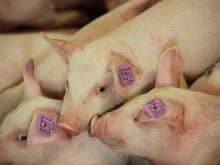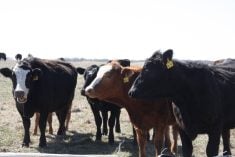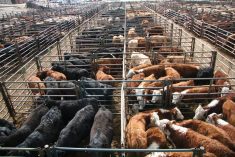A report in the latest issue of Bovine Practitioner compared the efficiency of two vaccines used to fight respiratory disease in cattle.
The two were Pyramid5 and Ex-press5, and there is a difference.
Undifferentiated fever/bovine respiratory disease (UF/BRD), commonly known as shipping fever, is an important contributor to losses in commercial feedlots. It causes illness, death and production losses.
Bacterial and viral infectious agents trigger UF/BRD.
Producers vaccinate their cattle with modified-live viral vaccines and bacterial toxoid vaccines to protect their cattle and limit the deleterious effects of this disease.
Read Also

VIDEO: Ag in Motion documentary launches second season
The second season of the the Western Producer’s documentary series about Ag in Motion launched Oct. 8.
Recent trials show that multivalent viral vaccines, which contain several viruses, are more cost effective and reduced illness and death and resulted in better average daily gain.
Pyramid5 and Express5 are both approved for vaccinating healthy cattle to prevent disease caused by IBR, BRS viruses and BVD types I and II, PI-3. However, no trial had compared the two.
A study was set up to compare the vaccines’ effect on animal health, feedlot performance and carcass characteristics in calves at high risk for developing UF/BRD.
It was carried out in a Nebraska feedlot with a one-time capacity of 85,000 feeders. The animals were exotic crossbred steer and bull calves averaging 230 to 242 kilograms.
In all, 3,264 animals were vaccinated with one of the two vaccines. All were revaccinated with their respective vaccines at 139 days on feed.
Animals were observed daily. Sick ones, determined by criteria such as attitude, appearance and willingness to move about, were moved to a hospital facility. A diagnosis of UF/BRD was based on the presence of fever and signs attributable to the respiratory system.
Initial treatment rates for UF were significantly lower in the Pyramid5 group over the Express5 group. However, there were no differences in relapses, disease persistence and overall illnesses or deaths.
There was no significant difference in average daily gain between the two vaccines, but Pyramid5 produced an improved dry matter-to gain ratio. Yield grades were also better with Pyramid5.
There was also an advantage of $1.36 US per animal in the Pyramid5 group, which was attributed to lower treatment costs and fewer lower grade carcasses.
Differences between the two vaccines include the adjuvant and the strain of BVD type II.
















